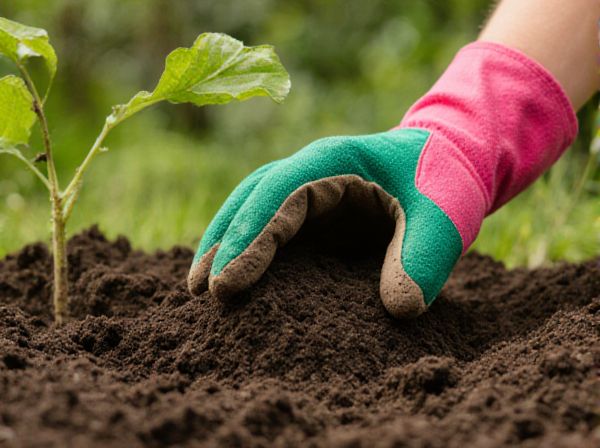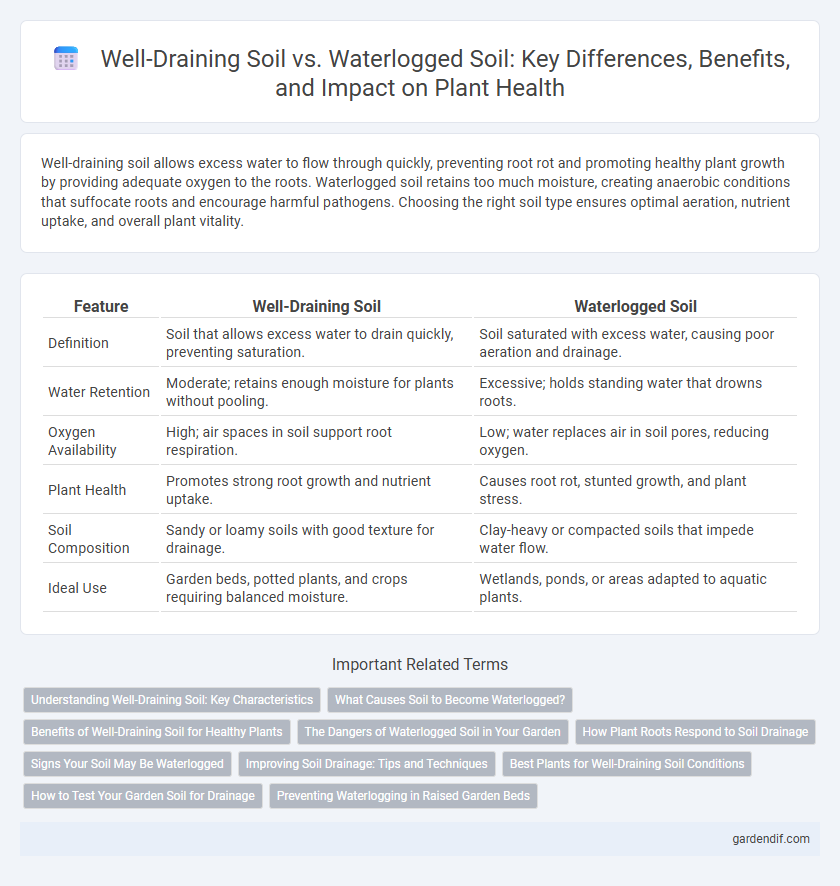
Well-Draining Soil vs Waterlogged Soil Illustration
Well-draining soil allows excess water to flow through quickly, preventing root rot and promoting healthy plant growth by providing adequate oxygen to the roots. Waterlogged soil retains too much moisture, creating anaerobic conditions that suffocate roots and encourage harmful pathogens. Choosing the right soil type ensures optimal aeration, nutrient uptake, and overall plant vitality.
Table of Comparison
| Feature | Well-Draining Soil | Waterlogged Soil |
|---|---|---|
| Definition | Soil that allows excess water to drain quickly, preventing saturation. | Soil saturated with excess water, causing poor aeration and drainage. |
| Water Retention | Moderate; retains enough moisture for plants without pooling. | Excessive; holds standing water that drowns roots. |
| Oxygen Availability | High; air spaces in soil support root respiration. | Low; water replaces air in soil pores, reducing oxygen. |
| Plant Health | Promotes strong root growth and nutrient uptake. | Causes root rot, stunted growth, and plant stress. |
| Soil Composition | Sandy or loamy soils with good texture for drainage. | Clay-heavy or compacted soils that impede water flow. |
| Ideal Use | Garden beds, potted plants, and crops requiring balanced moisture. | Wetlands, ponds, or areas adapted to aquatic plants. |
Understanding Well-Draining Soil: Key Characteristics
Well-draining soil is characterized by its porous texture, allowing excess water to flow freely and preventing root suffocation. Typically composed of sandy or loamy particles, it balances moisture retention with adequate aeration essential for healthy plant growth. In contrast, poorly draining soils, such as clay-heavy or compacted types, hold excess water, leading to waterlogged conditions that increase the risk of root rot and anaerobic stress.
What Causes Soil to Become Waterlogged?
Waterlogged soil occurs when excess water saturates the soil pores, preventing proper air circulation necessary for root respiration. Factors contributing to waterlogging include poor drainage due to compacted soil, high clay content, or a high water table close to the surface. Heavy rainfall, over-irrigation, and inadequate slope also trap water, leading to anaerobic conditions that harm plant growth.
Benefits of Well-Draining Soil for Healthy Plants
Well-draining soil prevents root rot by allowing excess water to flow away, promoting aeration essential for root respiration and nutrient uptake. This type of soil maintains optimal moisture levels, reducing the risk of fungal diseases and encouraging robust root development. Well-draining soil enhances plant health by supporting beneficial microbial activity and improving overall soil structure.
The Dangers of Waterlogged Soil in Your Garden
Waterlogged soil poses significant risks to garden health by limiting oxygen availability to plant roots, leading to root rot and stunted growth. Excess moisture creates an ideal environment for harmful fungi and bacteria, which can cause diseases such as damping-off and root crown rots. Poor drainage disrupts nutrient uptake, weakening plants and reducing overall garden productivity.
How Plant Roots Respond to Soil Drainage
Plant roots thrive in well-draining soil because it allows optimal oxygen availability and prevents root rot, promoting healthy root respiration and nutrient absorption. In contrast, waterlogged soil creates anaerobic conditions that restrict root oxygen intake, leading to root decay, impaired nutrient uptake, and stunted plant growth. Proper soil drainage ensures a balanced moisture environment, crucial for root development and overall plant vitality.
Signs Your Soil May Be Waterlogged
Persistent puddles on the surface and a strong, musty odor indicate that your soil may be waterlogged, preventing adequate oxygen from reaching plant roots. Wilting plants despite consistent watering and the presence of algae or moss growth are additional signs of poor drainage. Compacted soil texture and slow water absorption rate suggest an imbalance in soil structure that requires immediate attention to avoid root rot and reduced plant health.
Improving Soil Drainage: Tips and Techniques
Improving soil drainage involves incorporating organic matter such as compost or peat moss to enhance soil structure and porosity, allowing water to percolate more efficiently. Installing drainage systems like French drains or raised beds can prevent waterlogging by directing excess water away from plant roots. Aerating compacted soil with tools like a garden fork or mechanical aerator increases oxygen flow and reduces surface runoff, promoting healthier root development.
Best Plants for Well-Draining Soil Conditions
Succulents, lavender, and rosemary thrive in well-draining soil due to their low tolerance for excess moisture, which prevents root rot. Native grasses and Mediterranean herbs also perform well, benefiting from soils that allow quick water runoff and aeration. These plants require soil with high sand or grit content, ensuring optimal drainage and oxygen availability for healthy root development.
How to Test Your Garden Soil for Drainage
To test your garden soil for drainage, dig a hole about 12 inches deep and fill it with water, then observe how long it takes to drain completely; well-draining soil typically absorbs water within 1 to 2 hours, while waterlogged soil retains moisture for much longer periods. Another effective method is the percolation test, where you fill a hole with water and measure the time it takes for the water level to drop by one inch, indicating the soil's permeability. Proper soil drainage assessment is critical for optimizing plant health, preventing root rot, and ensuring balanced moisture levels in your garden environment.
Preventing Waterlogging in Raised Garden Beds
Well-draining soil in raised garden beds prevents waterlogging by facilitating efficient water movement and air circulation, reducing root rot and promoting healthy plant growth. Incorporating organic matter such as compost and perlite improves soil structure, enhances drainage, and retains optimal moisture levels. Elevating the soil and installing proper drainage systems further mitigate water accumulation, ensuring robust root systems and maximized crop yield.
Well-Draining Soil vs Waterlogged Soil Infographic

 gardendif.com
gardendif.com